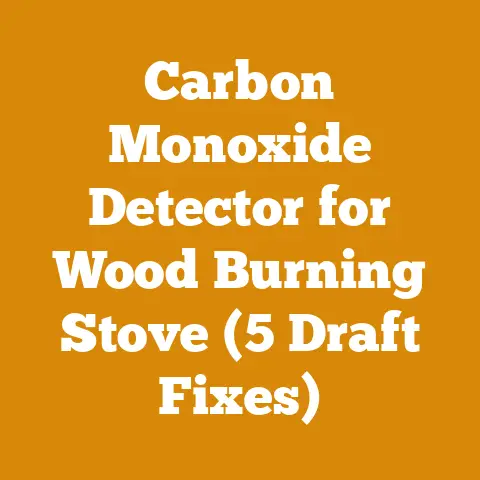Englander 25-PDV Stove Tips (5 Pro Woodburning Hacks)
It’s a paradox, really. The promise of a roaring fire, the cozy warmth of a wood-burning stove… yet, often, the reality is a frustrating struggle to maintain a consistent burn, battling smoky drafts, and wrestling with uncooperative fuel. Let’s address that paradox. My goal is to transform your experience with your Englander 25-PDV stove from a source of aggravation to a reliable heat source and a genuine pleasure. I’ve spent years immersed in the world of wood, from felling trees in the forests of the Pacific Northwest to meticulously preparing firewood for long winters. This guide isn’t just theory; it’s a distillation of hard-won experience, tailored specifically for the Englander 25-PDV.
Englander 25-PDV Stove Tips: 5 Pro Woodburning Hacks
This guide dives deep into optimizing your Englander 25-PDV stove. I will share five crucial hacks, each built on my personal experiences and observations. These aren’t just generic tips; they’re specific strategies designed to address common challenges and unlock the full potential of your stove. Let’s get started.
Hack 1: Mastering the Pellet Choice: Beyond BTUs
The Englander 25-PDV, unlike a traditional wood stove, relies on wood pellets. The quality of these pellets dramatically impacts performance. BTU ratings are important, but they don’t tell the whole story. I learned this the hard way after buying a pallet of “bargain” pellets.
The Pellet Quality Problem
The bargain pellets were a nightmare. They produced excessive ash, clogged the burn pot, and resulted in significantly less heat. The low price tag wasn’t worth the hassle. This experience pushed me to become a pellet connoisseur, experimenting with different brands and wood types.
Choosing the Right Pellet
- Ash Content: Aim for pellets with an ash content of 1% or less. High ash content means more frequent cleaning and reduced efficiency. I always check the manufacturer’s specifications.
- Wood Species: Hardwood pellets (oak, maple) generally offer higher BTU output and burn cleaner than softwood pellets (pine, fir). However, softwood pellets can ignite more easily. I often use a blend, starting with softwood for initial ignition and then transitioning to hardwood for sustained heat.
- Pellet Density: Denser pellets burn longer and more consistently. Look for pellets that feel heavy for their size.
- Moisture Content: The ideal moisture content for wood pellets is between 5% and 10%. Excess moisture leads to poor combustion and increased creosote buildup.
My Pellet Testing Method
I developed a simple method for testing pellet quality. I take a handful of pellets and submerge them in water for 30 seconds. High-quality pellets will remain relatively intact, while low-quality pellets will quickly disintegrate. This test gives me a quick indication of binding agent quality and overall density.
Actionable Metrics and Brands
- Premium Pellets: Look for brands like Lignetics, Cubex, and Okanagan. These consistently score well in independent tests.
- Ash Content Target: Aim for an ash content below 0.7%.
- BTU Target: Target a BTU rating of 8,000 BTU/lb or higher.
- Cost Considerations: While premium pellets cost more upfront, their superior performance and reduced maintenance often make them more cost-effective in the long run. I track my pellet consumption and cleaning frequency to calculate the true cost per BTU.
Takeaway: Don’t just look at the price tag. Invest in high-quality pellets to maximize your stove’s efficiency and minimize maintenance. Experiment to find the best pellet for your specific needs and climate.
Hack 2: Fine-Tuning the Air-to-Fuel Ratio: The Art of Combustion
The Englander 25-PDV relies on a precise air-to-fuel ratio for efficient combustion. A poorly adjusted ratio can lead to smoky fires, incomplete combustion, and wasted fuel. This is where understanding the stove’s control panel and airflow settings becomes crucial.
The Importance of Airflow
Too little air, and the fire smolders, producing smoke and creosote. Too much air, and the fire burns too hot and fast, wasting fuel and potentially damaging the stove. The goal is to find the sweet spot where the pellets burn cleanly and efficiently.
Understanding the Control Panel
The Englander 25-PDV typically has controls for adjusting the feed rate (amount of pellets delivered) and the air intake. The specific controls vary depending on the model year, so consult your owner’s manual.
My Airflow Adjustment Process
- Start with the Baseline: Begin with the factory-recommended settings for your pellet type and desired heat output.
- Observe the Flame: Watch the flame carefully. A healthy flame should be bright yellow with minimal smoke. A lazy, orange flame indicates insufficient air. A short, flickering flame suggests too much air.
- Adjust Incrementally: Make small adjustments to the air intake, no more than one increment at a time. Allow the stove to stabilize for 15-20 minutes after each adjustment before making further changes.
- Monitor the Exhaust: Check the exhaust vent for excessive smoke. A properly adjusted stove should produce minimal visible smoke.
- Check the Ash: Examine the ash in the burn pot. The ash should be light gray and powdery. Black, clumpy ash indicates incomplete combustion.
Case Study: The Smoky Stove
A friend of mine was struggling with a persistently smoky stove. He was using high-quality pellets and cleaning the stove regularly, but the problem persisted. After a thorough inspection, I discovered that the air intake was partially blocked by debris. Cleaning the intake immediately resolved the issue. This highlights the importance of regular maintenance and careful observation.
Advanced Adjustments
Some models of the Englander 25-PDV have adjustable air dampers. These dampers allow you to fine-tune the airflow based on the draft in your chimney. If you have a strong draft, you may need to close the damper slightly to prevent the fire from burning too hot. If you have a weak draft, you may need to open the damper to improve combustion.
Actionable Metrics
- Flame Color: Aim for a bright yellow flame with minimal smoke.
- Exhaust Smoke: Minimize visible smoke from the exhaust vent.
- Ash Color: Light gray and powdery ash indicates efficient combustion.
- Stack Temperature: Monitor the stack temperature. Refer to your owner’s manual for the optimal temperature range.
Takeaway: Mastering the air-to-fuel ratio is essential for efficient and clean burning. Experiment with the controls, observe the flame and exhaust, and adjust incrementally until you find the optimal settings for your stove and pellet type. Regular maintenance of the air intake is also crucial.
Hack 3: Deep Cleaning and Maintenance: Preventing Performance Degradation
Regular cleaning and maintenance are critical for maintaining the performance and longevity of your Englander 25-PDV stove. Neglecting these tasks can lead to reduced efficiency, increased risk of malfunctions, and even safety hazards. I’ve learned that a proactive approach to maintenance is far more effective than reactive repairs.
The Importance of Routine Cleaning
Ash buildup, creosote accumulation, and debris accumulation can all negatively impact your stove’s performance. Regular cleaning prevents these issues from escalating into major problems.
My Cleaning Schedule
- Daily: Empty the ash pan.
- Weekly: Clean the burn pot and heat exchanger tubes. I use a specialized brush for this purpose.
- Monthly: Inspect and clean the exhaust vent and chimney.
- Annually: Perform a thorough inspection of all components, including the auger, blower motor, and wiring. I also replace any worn or damaged parts.
Cleaning Tools
- Ash Vacuum: A dedicated ash vacuum is essential for safely and efficiently removing ash from the stove.
- Burn Pot Scraper: A burn pot scraper helps to remove clinkers and other debris from the burn pot.
- Heat Exchanger Brush: A specialized brush is needed to clean the heat exchanger tubes.
- Chimney Brush: A chimney brush is used to clean the exhaust vent and chimney.
- Screwdrivers and Wrenches: Basic tools are needed for disassembling and reassembling components.
Detailed Cleaning Procedures
- Empty the Ash Pan: Remove the ash pan and dispose of the ash in a metal container. Ensure the ash is completely cool before disposal.
- Clean the Burn Pot: Use the burn pot scraper to remove any clinkers or other debris from the burn pot. Vacuum the burn pot to remove any remaining ash.
- Clean the Heat Exchanger Tubes: Use the heat exchanger brush to clean the heat exchanger tubes. Vacuum the tubes to remove any dislodged ash.
- Inspect and Clean the Exhaust Vent and Chimney: Disconnect the exhaust vent and chimney. Use the chimney brush to clean the inside of the vent and chimney. Inspect for any blockages or damage.
- Inspect and Clean the Auger: Inspect the auger for any signs of wear or damage. Clean the auger tube to remove any debris that may be obstructing the auger.
- Inspect the Blower Motor: Inspect the blower motor for any signs of wear or damage. Clean the blower motor blades to remove any accumulated dust or debris.
Safety Precautions
- Disconnect Power: Always disconnect the stove from the power source before performing any cleaning or maintenance.
- Wear Protective Gear: Wear gloves and a dust mask to protect yourself from ash and other debris.
- Allow the Stove to Cool: Allow the stove to cool completely before performing any cleaning or maintenance.
Actionable Metrics
- Cleaning Frequency: Adhere to a regular cleaning schedule.
- Ash Accumulation: Monitor the rate of ash accumulation in the ash pan. A rapid increase in ash accumulation may indicate a problem with the pellets or the air-to-fuel ratio.
- Exhaust Vent Condition: Regularly inspect the exhaust vent for blockages or damage.
Takeaway: Regular cleaning and maintenance are essential for ensuring the efficient and safe operation of your Englander 25-PDV stove. Develop a cleaning schedule and adhere to it diligently. Use the appropriate tools and follow safety precautions. A well-maintained stove will provide years of reliable service.
Hack 4: Optimizing Heat Distribution: Moving Beyond the Stove’s Immediate Area
The Englander 25-PDV effectively heats the immediate area around the stove, but distributing that heat throughout your home requires some strategic planning. Over the years, I’ve experimented with various methods, from simple fans to more elaborate ducting systems. The key is to understand the principles of heat transfer and apply them to your specific home layout.
Understanding Heat Transfer
Heat naturally rises. This means that the hottest air will tend to accumulate near the ceiling. To effectively heat your entire home, you need to find ways to circulate that hot air to cooler areas.
Simple Solutions: Fans and Airflow
- Ceiling Fans: Running ceiling fans in reverse (clockwise) pushes warm air down from the ceiling. This is a simple and effective way to improve heat distribution.
- Box Fans: Placing box fans in doorways can help to circulate air between rooms. Position the fan to blow warm air from the stove room into adjacent rooms.
- Portable Fans: Small portable fans can be used to direct warm air into specific areas, such as hallways or bedrooms.
Advanced Solutions: Ducting and Zoning
- Ducting Systems: For larger homes, consider installing a ducting system to distribute heat from the stove to other rooms. This involves running ducts from the stove room to other areas of the house. A professional HVAC contractor can help you design and install a ducting system.
- Zoning Systems: Zoning systems allow you to control the temperature in different areas of your home. This can be particularly useful if you have rooms that are rarely used or that require different temperatures.
My Heat Distribution Setup
In my own home, I use a combination of strategies. I have a ceiling fan in the stove room that runs in reverse during the winter. I also use box fans in doorways to circulate air between rooms. For the bedrooms, which are located on the second floor, I rely on natural convection and strategically placed portable fans.
Case Study: The Cold Basement
A neighbor of mine was struggling to heat his basement. He had a wood stove on the main floor, but the basement remained stubbornly cold. After some experimentation, we discovered that the key was to create a pathway for warm air to flow down to the basement. We installed a small fan in the stairwell to push warm air down into the basement. This simple solution made a significant difference.
Addressing Specific Challenges
- Open Floor Plans: Open floor plans tend to be easier to heat because there are fewer barriers to airflow.
- Multi-Story Homes: Multi-story homes can be more challenging to heat because warm air naturally rises. Consider using fans to push warm air down to lower levels.
- Homes with Poor Insulation: Homes with poor insulation will lose heat more quickly, making it more difficult to maintain a consistent temperature. Improving insulation is often the most effective way to improve overall heating efficiency.
Actionable Metrics
- Temperature Differential: Measure the temperature difference between the stove room and other rooms in your home. The goal is to minimize this difference.
- Heating Time: Track how long it takes to heat your home to a comfortable temperature.
- Fuel Consumption: Monitor your fuel consumption to assess the effectiveness of your heat distribution strategies.
Takeaway: Optimizing heat distribution is crucial for maximizing the efficiency of your Englander 25-PDV stove. Experiment with different strategies to find the best solution for your specific home layout and heating needs. Consider both simple and advanced solutions, and don’t be afraid to seek professional help if needed.
Hack 5: Smart Storage and Handling: Preventing Pellet Degradation
Proper storage and handling of wood pellets are essential for maintaining their quality and ensuring optimal stove performance. Pellets are susceptible to moisture absorption, which can lead to reduced BTU output, increased ash production, and even mold growth. I’ve learned that investing in proper storage solutions is a worthwhile investment.
The Moisture Problem
Moisture is the enemy of wood pellets. When pellets absorb moisture, they swell, crumble, and lose their heating value. Wet pellets also burn poorly, producing excessive smoke and creosote.
My Storage Strategies
- Indoor Storage: The ideal storage location for wood pellets is indoors, in a dry, well-ventilated area. A garage, shed, or basement are all good options.
- Elevated Storage: Store pellets on pallets or other elevated surfaces to protect them from moisture wicking up from the floor.
- Waterproof Covers: Cover the pellets with waterproof tarps or plastic sheeting to protect them from rain and snow.
- Airtight Containers: For smaller quantities of pellets, consider using airtight containers to prevent moisture absorption.
Handling Techniques
- Minimize Exposure: Minimize the amount of time that pellets are exposed to the elements during handling.
- Use a Pellet Scoop: Use a pellet scoop to transfer pellets from the storage container to the stove hopper. This helps to prevent damage to the pellets.
- Inspect for Damage: Before adding pellets to the stove hopper, inspect them for any signs of damage or moisture absorption. Discard any damaged or wet pellets.
Case Study: The Moldy Pellets
A friend of mine stored his wood pellets outdoors, uncovered, for several months. When he finally went to use them, he discovered that they were covered in mold. The mold had not only ruined the pellets but had also contaminated the surrounding area. This experience highlights the importance of proper storage and handling.
Long-Term Storage
If you plan to store wood pellets for an extended period, consider using a desiccant to absorb any excess moisture. Silica gel packets are a good option for smaller containers. For larger quantities, you can use a dehumidifier in the storage area.
Actionable Metrics
- Moisture Content: Monitor the moisture content of your wood pellets. The ideal moisture content is between 5% and 10%.
- Storage Temperature: Maintain a consistent storage temperature. Avoid exposing pellets to extreme temperature fluctuations.
- Visual Inspection: Regularly inspect your pellets for any signs of damage or moisture absorption.
Takeaway: Proper storage and handling are essential for maintaining the quality of your wood pellets and ensuring optimal stove performance. Store pellets indoors, protect them from moisture, and handle them carefully. By following these simple guidelines, you can prevent pellet degradation and maximize your heating efficiency.
These five hacks, born from my years of experience, will help you unlock the full potential of your Englander 25-PDV stove. Remember, wood burning is both a science and an art. Experiment, observe, and adapt these techniques to your specific needs and environment. The reward will be a warm, comfortable home and the satisfaction of mastering a time-honored skill.






